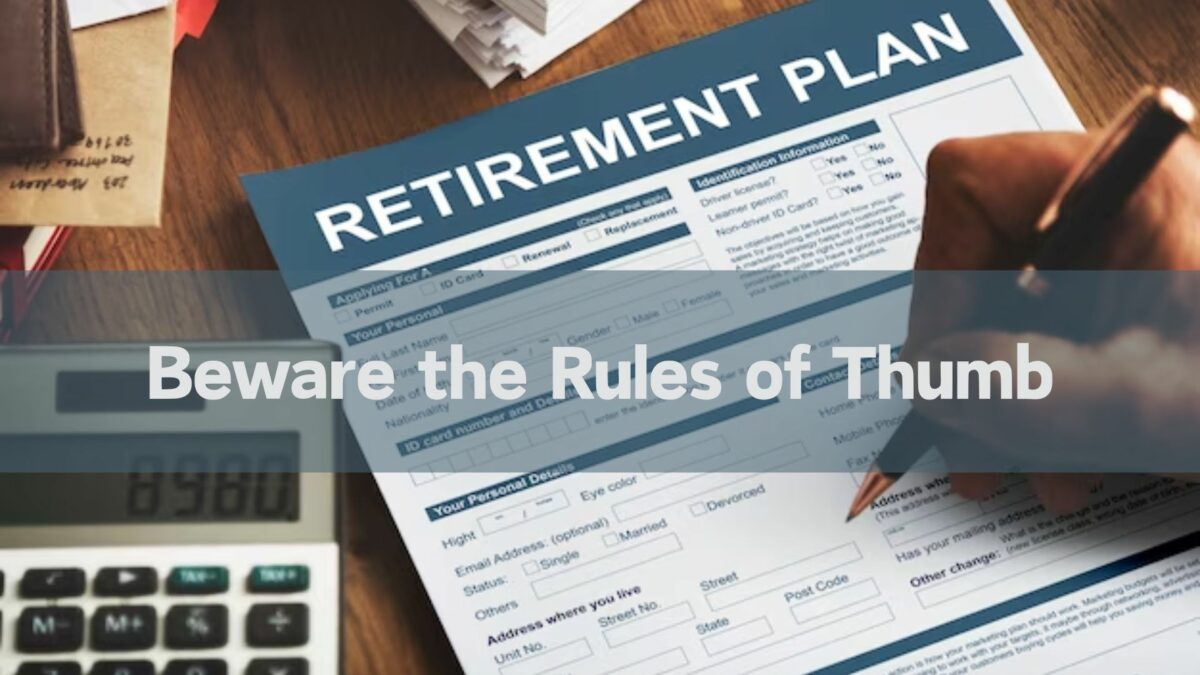“Half the truth is often a great lie.”
–Benjamin Franklin
In my previous article, I wrote about the 4% safe withdrawal rate.
There was one little hitch to what I wrote about, one that Matt from Mom and Dad Money was quick to point out.
The 4% safe withdrawal rate is supposed to be calculated from the point that you retire, not every year in retirement.
Yet, many people read the article and accepted it as truth.
I ran the article drawing from the flawed original premise to make a point.
It’s easy to mess up rules of thumb and follow them to inappropriate or dangerous conclusions.
Let’s look at some of these financial rules of thumb and find out how they can be misinterpreted.
These Rules of Thumb Need a Cast
The 4% Safe Withdrawal Rate
The true calculation of the safe withdrawal rate in retirement, as per William Bengen’s research, is based on needing retirement income for 30 years. Generally, at the time Bengen wrote the study, evaluations were made on retiring at age 65 and needing income generated from investments for 30 years. So, at age 66, your first year of needing retirement income, you’d take out 4% of your assets, and then increase that withdrawal by inflation every year for the next 30, assuming, to quote Bengen himself:
at a stock allocation as close to 75 percent as possible, and in no cases less than 50 percent.
Without digging a little bit deeper into the research and understanding the parameters around that number, it would be possible to draw a few potentially misleading conclusions:
- You can withdraw 4% of your assets each year. If that were the case, you’d experience the rollercoaster of spending that I described in the previous article. If you follow the 4% rule, you will withdraw less than 4% of your assets in some years (historically, most years), and more than 4% of your assets in some years.
- Asset allocation doesn’t matter. Bengen is clear that the sweet spot, according to his research, is between 50% and 75% stocks. The temptation is to go ultra-conservative once you retire, and even though, as we discussed in the article “Asset Allocation for Early Retirees,” that is applicable right after you retire, but not for your entire retirement.
- The rule applies no matter how long your retirement timeframe. Bengen’s research shows a safe maximum withdrawal rate for people who have a 30 year retirement timeframe. If you’re an early retiree, as I discussed in the article “Is 4% the Correct Safe Withdrawal Rate at Retirement?”, then you likely need to calculate a lower withdrawal rate.
From an Actuary’s Point of View, It Doesn’t Matter When You Take Social Security
Social Security is designed such that there will be just as many people drawing it beyond their life expectancy as who pass earlier than their life expectancy. If you take Social Security early and live to your life expectancy, then you’ll get just as much money as if you delayed until age 70.
Taken to its logical conclusion, then one could reason that it doesn’t matter when you take Social Security. After all, it’s meant to pay out the same amount through, depending on your situation, between ages 81 and 86 ½.
However, taking Social Security early in case you die early is not the goal of financial planning. It’s to make sure that you don’t run out of money before you run out of heartbeats.
By taking Social Security early, you’re solving the wrong problem. The issue isn’t retiring at age 62 and then peeling the garlic the next day. The issue is having enough money to support yourself in your 80s, 90s, and beyond.
Have an Emergency Fund

You want to make sure that you have funds available to you in case of a financial emergency so that you are not forced to go into debt to pay off the expenses.
However, that rule is not hard and fast.
If you’re already in consumer debt, then it doesn’t make sense to also have an emergency fund. That money should go to pay down your debt.
Otherwise, the emergency fund money sits in an account making virtually zero while your credit card debt is racking up interest, probably at a double digit rate. You’re extending the misery and the amount of time that it takes to pay off your debt by not using the money that you’ve already set aside for an emergency.
In other words, credit card debt is an emergency.
The knee-jerk reaction is to think “what if I put my entire emergency fund into paying off the credit card debt and then have an emergency the next day? What then, Mr. Smartypants?”
You use your credit card to pay it. Or, better yet, you get an extra job to pay for it. Or you withdraw contributions from your Roth IRA. Or, or, or…
In that event, which is actually pretty rare, you’re just playing a shell game by putting names on different sets of money. One of those sets comes at a high cost – your credit card debt.
But, by keeping that emergency fund when you have credit card debt, you’re playing defense against a situation that is unlikely to happen. For the times when you have no emergency requiring the emergency fund, you’re paying a high price to have the “just in case” fund floating around.
How Do You Protect Yourself From Rules of Thumb Injuries?
Don’t Accept Everything You Read or Hear as Gospel
It’s easy to read something on the Internet and accept it as true. Most of the time, it is. However, you also need to use your critical thinking skills to dig a little deeper.
- What’s the credibility of the provider of the information?
- Do others agree with the information provided?
- Have I heard this before?
- Have others used this information successfully?
You can train yourself to critically think. It involves asking yourself one question. I won’t spoil the surprise.
Look for the Exceptions
In most cases, rules of thumb apply under a given set of circumstances. The 4% safe withdrawal rate applies for people whose retirement window is 30 years or less and who invest in between 50% and 75% of their assets in equities. If you don’t fit that description, then the 4% safe withdrawal rate is probably not appropriate for you.
The corollary to this advice is to understand how the rules of thumb do apply. Bengen’s 4% safe withdrawal rate was determined from the assets at the first year of retirement and then adjusted annually for inflation. It was not, as I wrote in the previous ruse article, withdrawing 4% of your assets every year.
It’s not easy to think critically, particularly when there’s so much information available. It is mentally taxing. But, as we saw in the previous article, it’s easy to read something and accept it without question, particularly when just one error in fact can lead us down the wrong path and provide what appears to be credible results.
Yet, it’s important to think critically when we’re dealing with our retirement. Personal finance isn’t rocket surgery, but one misstep can have long-term bad consequences.
What about you? Have you every hammered your thumb using a rule? Let’s talk about it in the comments below!
Author Profile
- John Davis is a nationally recognized expert on credit reporting, credit scoring, and identity theft. He has written four books about his expertise in the field and has been featured extensively in numerous media outlets such as The Wall Street Journal, The Washington Post, CNN, CBS News, CNBC, Fox Business, and many more. With over 20 years of experience helping consumers understand their credit and identity protection rights, John is passionate about empowering people to take control of their finances. He works with financial institutions to develop consumer-friendly policies that promote financial literacy and responsible borrowing habits.
Latest entries
 Low Income GrantsSeptember 25, 2023How to Get a Free Government Phone: A Step-by-Step Guide
Low Income GrantsSeptember 25, 2023How to Get a Free Government Phone: A Step-by-Step Guide Low Income GrantsSeptember 25, 2023Dental Charities That Help With Dental Costs
Low Income GrantsSeptember 25, 2023Dental Charities That Help With Dental Costs Low Income GrantsSeptember 25, 2023Low-Cost Hearing Aids for Seniors: A Comprehensive Guide
Low Income GrantsSeptember 25, 2023Low-Cost Hearing Aids for Seniors: A Comprehensive Guide Low Income GrantsSeptember 25, 2023Second Chance Apartments that Accept Evictions: A Comprehensive Guide
Low Income GrantsSeptember 25, 2023Second Chance Apartments that Accept Evictions: A Comprehensive Guide

